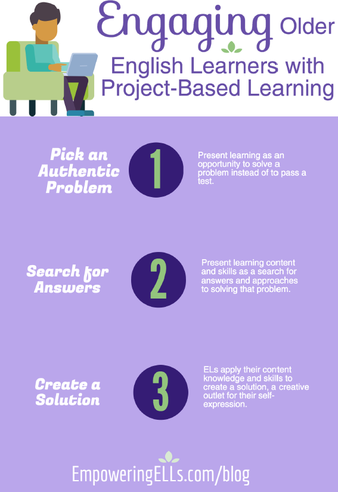|
I asked Tan Huynh, secondary ELT (English Language Arts Teacher) and educational blogger, to share with us how he engages his ELs at the secondary level. Here's what he said. Middle and high school students need a good reason to learn. Raging with pubescent hormones, they want to fluff their feathers and display their prowess, while at the same time living in fear about doing it. Nothing engages them more than an opportunity to express their uniqueness to make a real difference. So, as teachers, we need to find a way to give them one. We need to use problem-based learning (PBL). Pick an Authentic Problem
In elementary school, students need to learn the basic of literacy: how to decode text, develop social vocabulary, and develop reading, writing, and speaking fluency. But if you want to motivate ELs in secondary school, a singular focus on developing advanced literacy skills isn’t enough. We need to present a problem that secondary ELs can connect to - something with relevance to their lives that offers them a creative outlet. For example, the elementary school teachers at my school wanted help in teaching probability, a highly abstract concept. They reached out to the science, math, and design teachers in the secondary school to address this problem. Eager for a meaningful opportunity to teach this advanced concept, the secondary teachers shared the problem with their 8th graders, who were eager to take on the challenge. Because many ELs related to having a difficult time learning math in elementary school, they saw the task as being highly relevant to their experiences. Search for Answers ELs in upper elementary school start to learn about the research process, and in secondary school, this valuable skill becomes refined. Once the students were engaged, the secondary teachers reframed the purpose of one interdisciplinary unit from learning for a grade to taking actions to help others. This rebranding made acquiring content knowledge more relevant, and students saw a real purpose for learning: to create a carnival game that would teach elementary students about probability. The content helped the 8th graders search for answers and approaches to solve their problem. The science teacher required students to learn the physics of movement (pull, push, thrust), which was applied to mechanics of the carnival game. The math teacher needed the ELs to learn probability, which was how the game would work. And the design teacher wanted them to internalize the design cycle, inherent in the process of creating the game. All three educators were going to teach this content anyway, but now, by using problem-based learning examples, they anchored it to a real, meaningful context. The ELs were going to have to learn the content anyway, but now they have a purpose for learning. For many ELs, effort and concentration fades when learning is meaningless and starved of creativity. Create a Solution Because of the developmental nature of elementary school students, teachers need to guide them to create solutions. But in secondary school, educators encourage students to form their own answers from their own research. In our example, students were then expected to create a solution using the content knowledge and skills taught to them. ELs in secondary school blossom the most during this phase because of the creative freedom they’re given. It’s best to provide some guidelines and expectations around the kind of solution you’re looking for. One way is by co-creating the rubric used to evaluate the solution. Traditionally, we evaluate students by administering a test. However, in this student-centered model of learning, teachers can evaluate content knowledge and application of skills by critiquing the product. For this particular unit, the design teacher wanted to evaluate games’ designs. He asked the ELs for the characteristics of a high-quality game. Students replied that it should be engaging, be annotated with dimensions and labels, and only use the materials provided. Students added descriptors (such as sufficient and ineffective) to distinguish the different levels of success on the grading rubric. Having students co-construct the grading rubric raised the quality of their work because they were more aware the level needed to earn the highest distinction. Students weren’t surprised by their grade at the end. In fact, many accurately predicted their final scores based on the co-constructed rubric. Moreover, they are using language for an authentic purpose - to solve a real problem. Take Flight Teachers of ELs in elementary school nurture their students to grow strong wings and build their confidence to leave the safety of the nest. In secondary school, teachers nudge ELs to take flight by empowering them to use language to solve problems relevant to their lives. With problem-based learning, your ELs will soar and achieve great academic heights. Author: Tan Huynh, EmpoweringELLs.com Comments are closed.
|
Categories
All
|



 RSS Feed
RSS Feed
